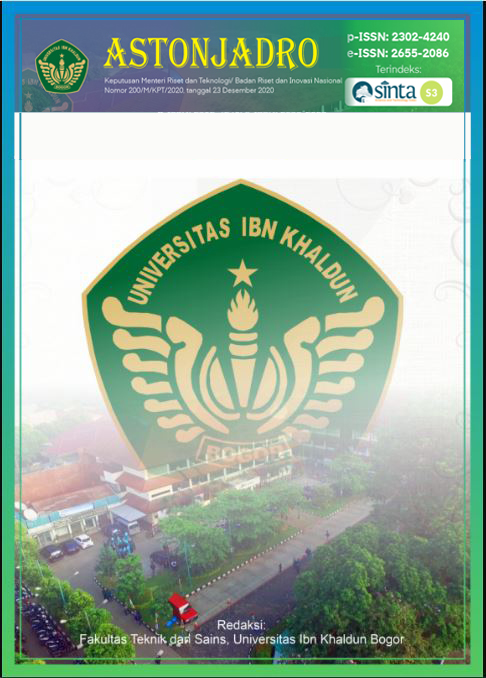Analysis of Vulnerability Level of Beach Abration Disaster in the District of North Galesong, Takalar Regency
DOI:
https://doi.org/10.32832/astonjadro.v11i3.7195Keywords:
vulnerability, disaster, abrasion, North Galesong, management activities.Abstract
Vulnerability is the inability of an individual or community group to minimize the impact caused by a hazard. Information about the level of vulnerability is essential to reduce the risks and effects caused by a disaster. Assessment of the level of vulnerability of threatened areas is carried out to minimise losses and the population exposed to disasters. This study aims to determine the level of vulnerability to coastal abrasion in North Galesong District, Takalar Regency. The analytical method used is the vulnerability index of coastal areas consisting of population components, namely population density and vulnerable groups, economic components, low-income families and anglers, physical components in the form of building density and ecological features in the form of mangrove vegetation. Analysis of vulnerability index data using the vulnerability assessment table issued by the Regulation of the Head of BNPB Number 2 of 2012. The overall results of the research are the vulnerability level of coastal villages in North Galesong District is in the high category. The category of high vulnerability is a condition of a community or society that leads to or causes a high inability to deal with the threat of coastal erosion in the North Galesong District. Vulnerability reduction activities can be carried out by increasing public understanding, especially vulnerable groups and poor fishers groups, through training and socialization activities regarding potential disaster threats, the driving factors for their occurrence and the risks. Socialization of the potential danger of abrasion and extreme waves for fishers is necessary to increase knowledge in dealing with disaster threats. Socialization can be done by inviting anglers to disaster management activities.
References
Adhietya, D, Mardiatna, D, & Giyarsih, S. R. (2017). Kerentanan Masyarakat Perkotaan Terhadap Bahaya Banjir di Kelurahan Legok, Kecamatan Telanipura, Kota Jambi. Jurnal Majalah Geografi Indonesia, 31, 79–87.
Arifin, Zaenal. (2010). Pola Spasial Kerentanan Bencana Alam (Studi Kasus Kabupaten Cianjur) [Tesis]. Fakultas Matematika dan Ilmu Pengetahuan Alam. Universitas Indonesia.
BNPB. (2012). Pedoman Umum Pengkajian Risiko Bencana. Badan Nasional Penanggulangan Bencana (BNPB).
Chaerul, M. (2022). Analisis Pengurangan Risiko Bencana Abrasi Pantai Di Kecamatan Galesong Utara Kabupaten Takalar. Syntax Literate: Jurnal Ilmiah Indonesia, 7(4), 13. http://dx.doi.org/10.36418/syntax-literate.v7i4.6726
Choirunisa, A. K. (2016). Kajian Kerentanan Fisik, Sosial, Dan Ekonomi Pesisir Samas Kabupaten Bantul Terhadap Erosi Pantai. 10.
Desfandi, M. (2016). Urgensi Kurikulum Pendidikan Kebencanaan Berbasis Kearifan Lokal Di Indonesia. SOSIO DIDAKTIKA: Social Science Education Journal, 1(2).
GR Josiana, & DR Hizbaron. (2019). Kajian Kerentanan Sosial dan Ekonomi Masyarakat Pesisir Terhadap Erosi Pantai di Pantai Trisik, Kulonprogo, DIY [Skripsi]. Universitas Gadjah Mada.
Hidayat, M. I. (2021). Arahan Pengurangan Risiko Bencana Abrasi Di Kawasan Permukiman Pesisir Desa Sampulungan, Kabupaten Takalar [Skripsi]. Universitas Hasanuddin.
Jatmiko, D. (2015). Pola Adaptasi Masyarakat Terhadap Abrasi Pantai: Studi di Kawasan Pesisir Samas, Bantul, Yogyakarta [Tesis]. Universitas Gadjah Mada.
Koddeng, B. (2011). Zonasi Kawasan Pesisir Pantai Makassar Berbasis Mitigasi Bencana (Studi Kasus Pantai Barombong-Celebes Convention Centre). Prosiding Hasil Penelitian Fakultas Teknik. Grup Teknik Arsitektur, Makassar.
Mantika, N. J., & Hidayati, S. R. (2020). Identifikasi Tingkat Kerentanan Bencana Di Kabupaten Gunungkidul. 1(1), 12.
Puspitotanti, E., & Karmilah, M. (2022). Kajian Kerentanan Sosial Terhadap Bencana Banjir. Jurnal Kajian Ruang, 1(2), 177. https://doi.org/10.30659/jkr.v1i2.20023
Putri, T. D. (2019). Analisis Kerentanan Sosial Masyarakat dan Adaptasi Perubahan IklimOdktiober2019 Kampung Gemblakan Atas, Kota Yogyakarta. Proceeding Biology Education Conference, 16, 256–264.
Rahmaningtyas, N., & Setyono, J. S. (2015). Tingkat Kerentanan Sosial Wilayah Kabupaten Wonogiri. Jurnal Teknik PWK, 4(4).
Ratu Nabillah, Iwan Setiawan, & Bagja Waluya. (2020). Kerentanan Sosial pada Wilayah Potensi Bencana Tsunami di Pesisir Kecamatan Rajabasa Kabupaten Lampung Selatan. Jurnal Geografi, Edukasi dan Lingkungan (JGEL), 4(2), 96–112. https://doi.org/10.29405/jgel.v4i2.4318
Rijanta, R, Hizbaron, D.R, & Baiquni, M. (2014). Modal Sosial dalam Manajemen Bencana.
Rusdi. (2014). Persepsi dan Adaptasi Masyarakat dalam Pengurangan Risiko Dampak Erosi Pantai di Kabupaten Pinrang Sulawesi Selatan [Tesis]. Fakultas Geografi, Universitas Gadjah Mada.
Setyaningrum, P, & Giyarsih, S.R. (2012). Identifikasi Tingkat Kerentanan Sosial Ekonomi Penduduk Bantaran Sungai Code Kota Yogyakarta Terhadap Bencana Lahar Merapi [Skripsi]. Fakultas Geografi, Universitas Gadjah Mada.
Utami, H., Veranita, & Pamungkas Adjie. (2013). Identifikasi Kawasan Rentan Terhadap Abrasi di Pesisir Kabupaten Tuban. Jurnal Teknik POMITS, 2(2), C14–C17. https://doi.org/10.12962/j23373539.v2i2.4340
Downloads
Published
How to Cite
Issue
Section
License
Copyright (c) 2022 ASTONJADRO: CEAESJ

This work is licensed under a Creative Commons Attribution-ShareAlike 4.0 International License.
Paper submitted to ASTONJADRO is the sole property of the Astonjadro Journal. Unless the author withdraws the paper because he does not want to be published in this journal. The publication rights are in the journal Astonjadro.ASTONJADRO
LICENSE
This work is licensed under a Creative Commons Attribution-ShareAlike 4.0 International License.
Based on a work at http://ejournal.uika-bogor.ac.id/index.php/ASTONJADRO













